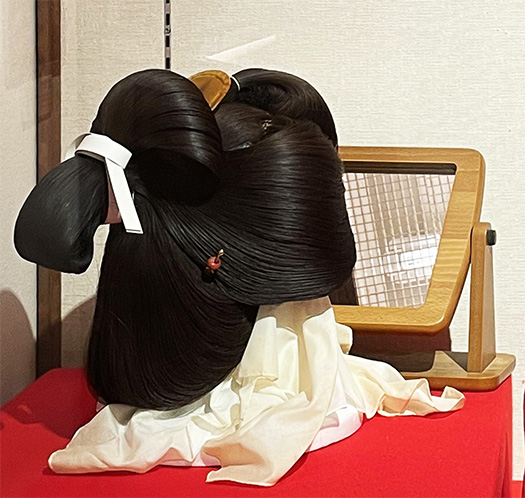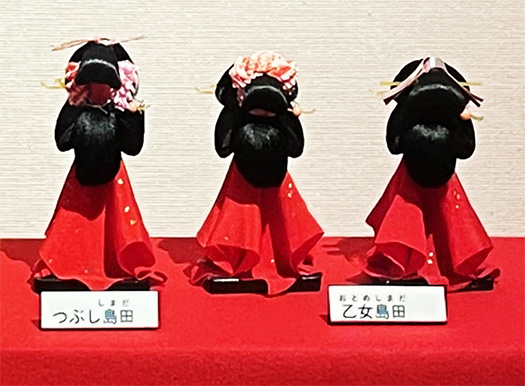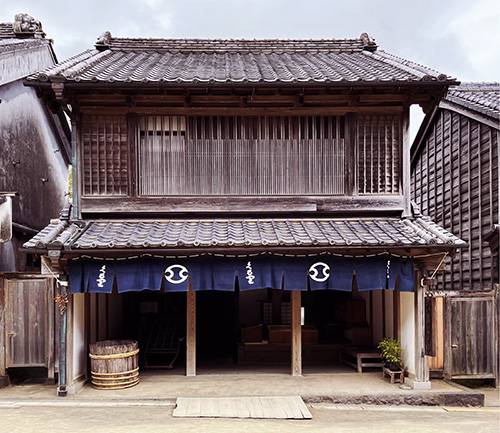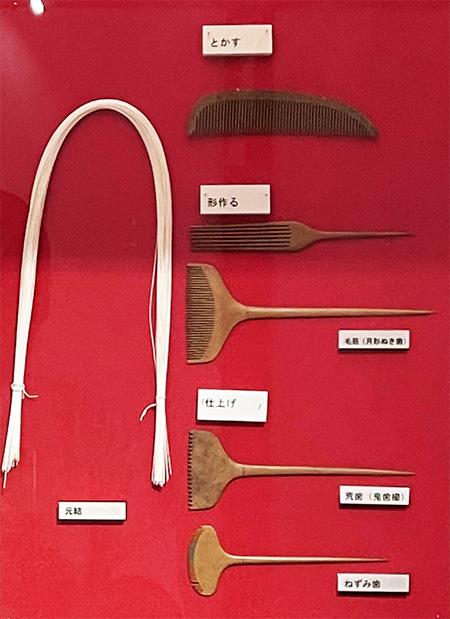

どんな時代でも女性は美を探求する。人間の本然として異性へのアピールというものが存在し、人間文化の中核に位置し続けている。日本では和服というファッションが成立し、それに似合った髪型が独特に発展して、江戸期女性は上のような結髪を施し、その重要なパーツとして鼈甲(べっこう)製品での髪飾りが盛況を究めていた。
髪に挿す櫛や「かんざし」の歴史は古く、すでに縄文の晩期頃には用いられていたという。奈良期ころまでは髪は束ねられ「結う」ことが行われた。平安時代以降、女性は垂髪となった。〜垂髪(すべらかし)とは、婦人の下げ髪の一種で十二単(じゅうにひとえ)を着る時の後ろに長く垂れ下げた髪型のこと。〜
室町時代末期からはまた「結い上げ」始め江戸時代には一般に広まって多数の独特の「髪型」というものが登場し「流行」現象が見られ始めたのでしょうか。それに伴ってさまざまな材質や形のものが一世を風靡するようになる。「房総のむら」では「小間物屋くる里」という店舗として紹介されていました。

日本の産業史としては北海道のニシン漁と北前船交易の大きな起動要因として、綿花栽培の魚肥として必要とされて本州地区の農家の畑で重厚に施肥された。その綿花を使って女性服が仕立てられ、最大のファッション産業が成立したのだとされる。それは主に上方・京呉服というブランドを成立させ、消費都市江戸に「下って」いった。下らないという言葉はこういう日本文化事情から出現していった。まことに女性美の探求は日本文化最大の起爆剤ですね、あな怖ろしや(笑)。

櫛・笄(こうがい)・簪(かんざし)などの髪飾りや白粉・紅などの化粧品をはじめ、塗り物の器や箱物、眼鏡、刃物、袋物、煙草入れ、根付など、こまごまとした日用品を商った。これらの商品は小間物問屋に集荷され小売りの小間物屋がそれらを仕入れた。主に女性生活用品なので客は女性が多く、小間物売りも女性が多かったといわれる。近代に入って次第に化粧品・服飾品などの種類が増え需要増加に伴い、小間物屋の多くは洋品店・化粧品店など専門店分化した。
小間物屋では中程度の小間物屋には、常時番頭を含めて4~5人の店員がいたという。座売りを主体としていた。同時に行商として竹カゴ数個を重ねて中に小間物類を入れて風呂敷に包み、背負って家々を訪ね売ることもした。当時は櫛や簪類も本物のべっ甲を使っており、虫がつきやすいので売れるまで虫除けの樟脳を入れるなど、気を使うことが多かったのという。
それにしても和服とこうした髪型という独自の審美眼というのは、非常に面白い日本女性美文化。こういう美の極限文化を持ちながら、西洋の審美文化も旺盛に取り入れたワケだ。そこにさまざまなフュージョンが生成したことも疑いない。
English version⬇
Edo Period, Boso Townhouse-5] “Hair Decoration & Hairdressing” – An Exploration of the Beauty of Japanese Women
The culture of hairstyles is like a pole point created by the aesthetic sense of Japanese women. The sublime search for beauty is deeply felt. The hair of the Edo period
Naturally, women in every age search for beauty. Appeal to the opposite sex exists as human nature, and it continues to be at the core of human culture. In Japan, the fashion of kimonos was established, and hairstyles that matched kimonos developed in a unique way.
The history of combs and “kanzashi,” or hairpins, is long, and they were already in use as early as the late Jomon period (710-794). Until around the Nara period (710-794), hair was bound and “tied”. After the Heian period (794-1185), women began to wear their hair in a slicked-back bun. 〜The term “slicked-back hair” refers to a type of lowered hairstyle worn by women when wearing the junihitoe (twelve-layered kimono), in which the hair hangs down long in the back. ~.
The “yuiage” hairstyle began to appear again at the end of the Muromachi period (1333-1573) and spread to the general public in the Edo period (1603-1867), and many unique “hairstyles” appeared and became “fashionable. In the Edo period, a variety of materials and shapes came to dominate the market. In “Boso no Mura”, it was introduced as a store called “Komono-ya Kururi”.
In Japan’s industrial history, the herring fishery in Hokkaido and trade with the Kitamae-bune were major factors in launching the industry, and it was heavily fertilized in the fields of farmers in the Honshu area, as it was needed as fish manure for cotton cultivation. It is believed that women’s clothing was tailored using this cotton, and the largest fashion industry was established. It is said that the greatest fashion industry was established using the cotton to tailor women’s clothing, which was mainly branded as Kamigata/Kyo kimono, and then “went down” to the consumer city of Edo. The word “shitaoranai” emerged from this Japanese cultural context. The search for feminine beauty is truly the greatest catalyst of Japanese culture.
They sold hair ornaments such as combs, Kougai (hairpin) and hairpins, cosmetics such as Shiroko (white powder) and rouge, and other daily necessities such as lacquered vessels, box goods, glasses, cutlery, bags, tobacco pouches, and netsuke (ornamental diapers). These goods were collected by koyomono wholesalers and purchased by retail koyomono shops. Since these goods were mainly women’s daily necessities, many of the customers were women, and it is said that many of the komono sellers were also women. In the modern era, the variety of cosmetics and accessories gradually increased, and as demand for these items grew, many komamono shops became specialty stores such as Western-style clothing stores and cosmetics stores.
A medium-sized haberdashery shop always had four to five staff members, including a watchman. The main business was selling goods on the floor. At the same time, they also peddled by carrying several bamboo baskets stacked one on top of the other, wrapped them in furoshiki (wrapping cloth), and sold them from house to house on their backs. In those days, combs and hairpins were made of real tortoiseshell, which was prone to attract insects, so they had to be carefully packed with camphor to keep insects away until sold.
The unique aesthetic sense of kimono and hairstyles is a very interesting part of the Japanese women’s beauty culture. While maintaining such an extreme culture of beauty, they also vigorously adopted Western aesthetic culture. There is no doubt that a variety of fusions were created in this culture.
Posted on 1月 12th, 2023 by 三木 奎吾
Filed under: 日本社会・文化研究, 歴史探訪







コメントを投稿
「※誹謗中傷や、悪意のある書き込み、営利目的などのコメントを防ぐために、投稿された全てのコメントは一時的に保留されますのでご了承ください。」
You must be logged in to post a comment.